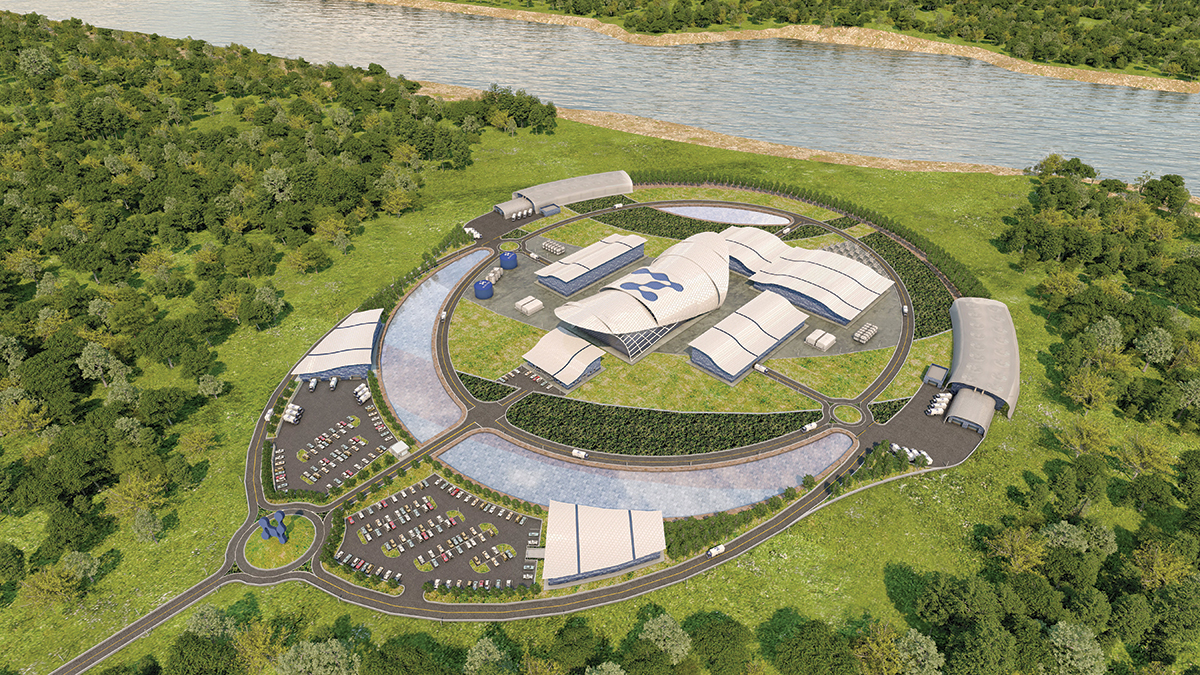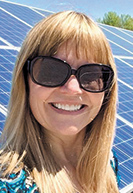Subscriber Benefit
As a subscriber you can listen to articles at work, in the car, or while you work out. Subscribe Now
One state at a time, public officials are setting out the welcome mat for nuclear power.
Five years ago, Kentucky lifted its 25-year-old ban on construction of nuclear power plants.
Last year, Montana ended its 43-year moratorium on nuclear construction.
Last week, the West Virginia Legislature repealed a long-standing state code that says nuclear power “poses an undue hazard to the health, safety and welfare” of the state and virtually banned construction of nuclear plants.
These and other once-leery states are taking a new look at nuclear power as a way to preserve jobs and help decarbonize the electric grid.
And now, Indiana is debating whether to go down a similar road.

On Tuesday, the Republican-controlled Senate passed a bill by a vote of 39-9, mostly along party lines, that would allow electric utilities to install small, modular reactors that could generate up to 350 megawatts of electricity, enough to power a small city of about 250,000 homes. The bill is now before the Republican-controlled House.
“This bill will create a framework for Indiana, if it so decides to move into the world of small nuclear modular reactors,” Sen. Eric Koch, chair of the Senate Utilities Committee, said at a hearing in January.
It’s a huge shift for Indiana, which has never had commercial nuclear power and has long relied on coal—and more recently, natural gas, wind and solar energy—to power homes and factories.
As nuclear advocates press their case before the Indiana General Assembly, the question remains whether any utilities have plans to build a nuclear plant anytime soon—within the next decade or two.
It’s hard to tell. The technology for small modular reactors is brand new. No plants have yet been built anywhere in the United States. And 13 states still have bans or restrictions on nuclear power construction.

Only one company, NuScale Power Inc., based in Portland, Oregon, has received design approval from the Nuclear Regulatory Commission for its small modular reactors. The company is still in the early stages of building its first one for a municipal power company at the Idaho National Laboratory, a site owned by the U.S. Department of Energy.
NuScale officials declined to say whether they were in advanced discussions with any Indiana utilities. But they said building a plant is not an overnight proposition.
“If a customer tells us today they want us to deliver a NuScale Power plant in the United States, the timetable is roughly seven years,” Tom Mundy, the company’s chief commercial officer, told IBJ. “You have to do some licensing activities. You have to do some project-specific engineering activities. You have to mobilize. You have to build the plant, and you have to commission the plant.”
He said NuScale Power is studying utilities all over the country that have announced plans to retire coal-fired units. The company’s modules are built to take over power generation at shuttered plants.
NuScale, founded in 2007, announced last month that it would go public this year under a merger with “blank check” company Spring Valley Acquisition Corp., signaling that Wall Street believes the company has a bright future.
Shifting future

Gov. Eric Holcomb supports a diverse approach to energy generation, possibly including nuclear power, said Ryan Hadley, executive director of the Indiana Office of Energy Development.
“As we navigate and manage Indiana’s electric generation transition, it’s important for policymakers to discuss and address new and emerging technologies, such as small modular reactors and underground pumped storage hydropower, and how they may impact Indiana’s future generation of electricity,” Hadley told IBJ.
Nuclear advocates, including business groups and utilities, say small reactors are a smart way to shift the nation’s energy generation. They say the modules are more efficient and safer than traditional reactors, and are smaller and quicker to build.
The small reactors are designed to be manufactured and assembled on-site in factories that can fit on 20 to 35 acres. Traditional nuclear power plants can sprawl across more than 1,000 acres.
NuScale said its reactors are about 75 feet tall and 15 feet in diameter, and could be bundled in groups of four, six or 12.
The Nuclear Energy Institute, a trade association, told the Indiana Senate Utilities Committee last month that modular reactors could be built on the site of retired coal-burning plants. It touts the power as “clean energy,” meaning it produces energy by splitting uranium atoms, but does not emit carbon dioxide, sulfur dioxide or nitrogen oxides as traditional coal-fired plants do.
“The only difference is that, instead of burning coal, you’re splitting an atom,” said Marcus Nichol, the institute’s senior director of new reactors.
The Biden administration has touted nuclear power as a source of clean, reliable power, and supports small modular reactors as part of a plan to reach a net-zero carbon future by 2050.
The United States still leads the world in nuclear energy output by a large margin, followed by France, China, Russia and South Korea, according to Scientific American, citing figures from the International Atomic Energy Agency.
But environmentalists, consumer groups and even some civil rights groups, including the NAACP, oppose the nuclear plants.
They say building nuclear reactors is hugely expensive and the cost should not be shifted to ratepayers. They add that reactors have their own form of waste: spent uranium fuel, which is stored in pools or steel-lined concrete vaults for decades.
It’s unclear how much a small modular reactor would cost. Mundy at NuScale said the average price is about $3 billion.
But the Idaho project has run higher when outside costs are factored in. The Utah Municipal Power System, the customer that has contracted for the Idaho project, recently said it could cost an additional $3 billion, including interest, contingency fees, warranties and other costs.
Spiraling costs
It’s been more than four decades since Indiana tried to build a nuclear power plant, and that experience was a financial disaster. A small utility, then known as Public Service Indiana, started building a nuclear plant in the late 1970s in southern Indiana, at an estimated cost of $700 million.
But costs soared as the plant ran into one problem after another. As the price tag, including runovers, soared above $2.5 billion, PSI ran out of money and pulled the plug on the half-built Marble Hill Nuclear Power Station. The plant was later dismantled and sold for parts. The utility went through a series of mergers and became part of Duke Energy Corp.
And now, cost is a big sticking point for the legislation. Some consumer watchdogs say that, unlike the Marble Hill project, customers could get stuck paying for construction of a small modular reactor before it generates its first kilowatt hour of electricity.That’s because the legislation, Senate Bill 271, adds the reactors to the definition of clean energy technologies that are eligible for financial incentives, including recovering construction costs before the plants even go online, through monthly trackers added onto utility bills.
That process is known as “construction work in progress,” or CWIP, and allows utilities to pass front-end costs to ratepayers years in advance of the plant’s going online.
CWIP was used on another costly utility project, Duke Energy’s Edwardsport power plant. That plant, originally approved by Indiana regulators at $1.9 billion, soared to more than $3.3 billion, with ratepayers picking up much of the increase.
Shortly after going into service, the Edwardsport plant suffered repeated operating and maintenance problems, requiring expensive repairs that cut into productivity.

Kerwin Olson, executive director of Citizens Action Coalition, said nuclear power plants are extremely expensive, and that Edwardsport should have served as a lesson about shifting costs onto customers.
“We are astonished by the total indifference to utility consumers,” he said. “One would think that Edwardsport would serve as a prime example of why CWIP for technology that is risky and not yet commercially available is terrible public policy and a raw deal for customers. We are supposed to learn from our mistakes, not repeat them.”
The bill’s author, Koch, has said the bill does not provide CWIP funding for small modular reactors, and that utilities would have to go through a rate case with state regulators. Through a spokeswoman, Koch declined an interview with IBJ.
Not anytime soon
The Indiana General Assembly set up a blue-ribbon panel three years ago to guide lawmakers in crafting a long-term energy plan. The panel, called the 21st Century Energy Policy Development Task Force, said renewable energy is less reliable and stable than energy from other sources, and that “to compensate for the unreliability and instability of electricity generated from renewables, backup sources of generation are required, such as generation from fossil fuels, nuclear resources,” and other energy sources.

Some environmental groups, including the Sierra Club, disagree with that conclusion.
“Renewable energy resources are sufficient to address climate change and are cheaper than nuclear power,” said Wendy Bredhold, Indiana representative for the organization’s Beyond Coal Campaign. “Legislative leadership refuses to even hear most of the bills that offer true climate solutions and are on a path that benefits special interests over Hoosiers.”
It will take buy-in from a key sector, Indiana’s utilities, to advance nuclear power. And no utility has yet expressed a firm intention to install a small reactor.
The Indiana Energy Association, which lobbies on behalf of the largest electric utilities in the state, including AES Indiana and Duke Energy Indiana, said its members are still studying the issue.

“We are not aware of any plans [to install SMRs],” said Danielle McGrath, the group’s president. “However, our member companies continue to plan for the long term and explore different options to best serve their customers.”
Indiana utilities are required to update their 20-year generation plans every three years, and outline what technologies they plan to use to make electricity.
AES Indiana, which serves about 500,000 customers in the Indianapolis area, is holding public meetings this year to discuss generation, and said it will file a plan by Nov. 1.
“SMRs are one of the technologies we are following closely as we go through our IRP process,” said Kelly Young, a spokeswoman for AES Indiana, formerly known as Indianapolis Power & Light Co. “As a company, we see these technologies as providing optionality in a path towards reducing carbon and we plan to consider them in future IRPs as they become commercially available.”
The utility has said it plans to retire two of the four coal-burning units at its massive Petersburg Generating Station by next year. The power plant, about 120 miles southwest of Indianapolis, is the largest in the AES Indiana fleet. The two remaining coal-burning units at Petersburg could run until at least 2042.
Duke Energy Indiana, the state’s largest electric utility, said it has no plans to build a small modular reactor. But the Plainfield-based utility is “closely watching advancements in technology” that can provide carbon-free and reliable power generation, spokeswoman Angeline Protegere said.
Northern Indiana Public Service Co. said in November it plans to retire all its remaining coal-fired generators from 2026 to 2028, with its largest plant retired by next year. It plans to replace it with a mix of natural gas, solar, large-battery energy storage, and other renewables.
The Merrillville-based utility, an operating unit of NiSource Inc., said it did not receive any bids from SMR vendors to install nuclear power at its generating sites.
“In addition, there remain uncertainties regarding the cost, performance and availability of the technology,” the utility said in its resource plan. “As a result, NIPSCO has not evaluated SMR technology as a realistic resource option associated with the implementation of its preferred portfolio over the next several years.”•
Please enable JavaScript to view this content.


Democrats and liberals being opposed to nuclear is so hypocritical (and this is coming from a liberal.) Renewables are great and fill a void, but there need to be reliable backup options. So you don’t want coal and natural gas? Then support nuclear.
Sometimes a minority party will vote against something that is clearly going to pass just to appease a fringe group of their constituency. I wouldn’t be surprised if that happened in this case.
Nuclear power is clearly one of the most viable options both for energy independence – meaning our energy sources are not impacted by volatile global markets – and going green. That said, I don’t want it if Indiana isn’t going to be serious about public and environmental safety. If Indiana can’t stop industry from dumping toxic waste into Lake Michigan every two years, can Indiana stop a nuclear power plant from making a grave mistake? I’m not sure.
I’ve responded here in the recent past about electrical power generation. This article re: the legislature hearing about nuclear power generation possibilities in Indiana is again some big deal announcement out to utility companies they may have the door opened to permit nuclear someday. Before legislators, the governor get all giddy and sip on some pro-nuclear power kool-aid, kindly everyone Google, Vogtle Power Plant, currently being expanded by Georgia Power. There have been cost overruns on top of cost overruns, project delays on top of more construction delays and stop-starts. Units 3 & 4, the units still being constructed are ESTIMATED to cost more than $25 billion, if even that. How about that word ESTIMATED, means open checkbook. And closer to home, and maybe still not forgotten by legislative minds, Duke Energy’s coal gasification plant cost overrun fiasco in Edwardsport, IN that essentially doubled in cost since groundbreaking. Ridiculous!!!!! Engineering fiasco. Vogtle Plant in Georgia…….Google it Governor and legislators. Ratepayers in Georgia will pay dearly for every kilowatt hour of electricity from that plant. That friends is unsustainable. Better start saving so you can pay exorbitantly for a kilowatt-hour electricity. 50 -75 cents per kwh???? Higher yet????
The NAACP opposes clean low-cost nuclear power?
Why on God’s Earth would they oppose that?
I will preface this by saying that I am pro-nuclear power.
It’s probably something like this:
Power plants create hazardous waste, that can leach into the environment or me emitted into the environment. This can have negative public health effects for people living near power plants. Poverty rates are relatively high among POC, so a disproportionate number of POC live near power plants. Thus, the NAACP doesn’t want nuclear waste or a nuclear meltdown happening in neighborhoods with many poor vulnerable people.
That said, if nuclear waste and nuclear power plants are properly managed, it’s not a problem. It would actually be cleaner than coal and natural gas. But humans are generally pretty incompetent and Indiana is pretty bad about environmental oversight, so who actually knows if a prospective nuclear power plant and its waste would be properly managed.
Bring it on we need it soooo badly!!!
Maybe we should replace the state slogan with the “Boondoggle State.” Boondoggles are the hallmark of Indiana energy policy – underscored by the author of the modular nonsense unit bill working its way through the State House misreading his own bill. Nukes have never been built without shifting construction risk to ratepayers – utilities knowing the private sector wouldn’t touch them without making raptepayers wallets their personal bank. Nuclear power is the only electric power technology with a negative learning curve – costs have always escalated, never decline, despite massive taxpayer funded R&D budgets – unlike solar, wind, battery storage, energy efficiency and demand response technologies. NuScale’s modular unit has already experienced $3 billion in cost overruns in the design phase – with the DOE continuing to shovel taxpayer dollars into it. The incompetence of the Indiana General Assembly in these matters is astounding.